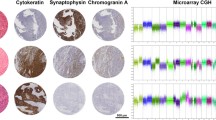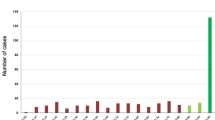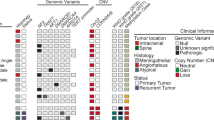Abstract
Olfactory neuroblastoma/esthesioneuroblastoma (ONB) is an uncommon neuroectodermal neoplasm thought to arise from the olfactory epithelium. Little is known about its molecular pathogenesis. For this study, a retrospective cohort of n = 66 tumor samples with the institutional diagnosis of ONB was analyzed by immunohistochemistry, genome-wide DNA methylation profiling, copy number analysis, and in a subset, next-generation panel sequencing of 560 tumor-associated genes. DNA methylation profiles were compared to those of relevant differential diagnoses of ONB. Unsupervised hierarchical clustering analysis of DNA methylation data revealed four subgroups among institutionally diagnosed ONB. The largest group (n = 42, 64%, Core ONB) presented with classical ONB histology and no overlap with other classes upon methylation profiling-based t-distributed stochastic neighbor embedding (t-SNE) analysis. A second DNA methylation group (n = 7, 11%) with CpG island methylator phenotype (CIMP) consisted of cases with strong expression of cytokeratin, no or scarce chromogranin A expression and IDH2 hotspot mutation in all cases. T-SNE analysis clustered these cases together with sinonasal carcinoma with IDH2 mutation. Four cases (6%) formed a small group characterized by an overall high level of DNA methylation, but without CIMP. The fourth group consisted of 13 cases that had heterogeneous DNA methylation profiles and strong cytokeratin expression in most cases. In t-SNE analysis, these cases mostly grouped among sinonasal adenocarcinoma, squamous cell carcinoma, and undifferentiated carcinoma. Copy number analysis indicated highly recurrent chromosomal changes among Core ONB with a high frequency of combined loss of chromosome 1–4, 8–10, and 12. NGS sequencing did not reveal highly recurrent mutations in ONB, with the only recurrently mutated genes being TP53 and DNMT3A. In conclusion, we demonstrate that institutionally diagnosed ONB are a heterogeneous group of tumors. Expression of cytokeratin, chromogranin A, the mutational status of IDH2 as well as DNA methylation patterns may greatly aid in the precise classification of ONB.






Similar content being viewed by others
Change history
09 August 2018
In the original publication, the second name of the twentieth author was incorrect. It should read as ‘Miguel Sáinz-Jaspeado’. The original publication of the article has been updated to reflect the change. This correction was authored by Ulrich Schüller on behalf of all authors of the original publication.
References
Abe M, Ohira M, Kaneda A, Yagi Y, Yamamoto S, Kitano Y et al (2005) CpG island methylator phenotype is a strong determinant of poor prognosis in neuroblastomas. Cancer Res 65:828–834
Abecasis GR, Altshuler D, Auton A, Brooks LD, Durbin RM, Gibbs RA et al (2010) A map of human genome variation from population-scale sequencing. Nature 467:1061–1073. https://doi.org/10.1038/nature09534
Abedalthagafi MS, Merrill PH, Bi WL, Jones RT, Listewnik ML, Ramkissoon SH et al (2014) Angiomatous meningiomas have a distinct genetic profile with multiple chromosomal polysomies including polysomy of chromosome 5. Oncotarget 5:10596–10606. https://doi.org/10.18632/oncotarget.2517
Argani P, Perez-Ordonez B, Xiao H, Caruana SM, Huvos AG, Ladanyi M (1998) Olfactory neuroblastoma is not related to the Ewing family of tumors: absence of EWS/FLI1 gene fusion and MIC2 expression. Am J Surg Pathol 22:391–398
Bockmuhl U, You X, Pacyna-Gengelbach M, Arps H, Draf W, Petersen I (2004) CGH pattern of esthesioneuroblastoma and their metastases. Brain Pathol 14:158–163
Bridge JA, Bowen JM, Smith RB (2010) The small round blue cell tumors of the sinonasal area. Head Neck Pathol 4:84–93. https://doi.org/10.1007/s12105-009-0158-6
Capper D, Jones DTW, Sill M, Hovestadt V, Schrimpf D, Sturm D et al (2018) DNA methylation-based classification of central nervous system tumours. Nature 555:469–474. https://doi.org/10.1038/nature26000
Carney ME, O’Reilly RC, Sholevar B, Buiakova OI, Lowry LD, Keane WM et al (1995) Expression of the human Achaete-scute 1 gene in olfactory neuroblastoma (esthesioneuroblastoma). J Neurooncol 26:35–43
Cha S, Lee J, Shin JY, Kim JY, Sim SH, Keam B et al (2016) Clinical application of genomic profiling to find druggable targets for adolescent and young adult (AYA) cancer patients with metastasis. BMC Cancer 16:170. https://doi.org/10.1186/s12885-016-2209-1
Cha S, Lee S-H, Kim J-I, Shin J-Y (2014) Abstract 4191: Whole exome sequencing of a case of olfactory neuroblastoma. Cancer Res 74:4191. https://doi.org/10.1158/1538-7445.am2014-4191
Cohen ZR, Marmor E, Fuller GN, DeMonte F (2002) Misdiagnosis of olfactory neuroblastoma. Neurosurg Focus 12:e3
Cordes B, Williams MD, Tirado Y, Bell D, Rosenthal DI, Al-Dhahri SF et al (2009) Molecular and phenotypic analysis of poorly differentiated sinonasal neoplasms: an integrated approach for early diagnosis and classification. Hum Pathol 40:283–292. https://doi.org/10.1016/j.humpath.2008.07.019
Dogan S, Chute DJ, Xu B, Ptashkin RN, Chandramohan R, Casanova-Murphy J et al (2017) Frequent IDH2 R172 mutations in undifferentiated and poorly-differentiated sinonasal carcinomas. J Pathol 242:400–408. https://doi.org/10.1002/path.4915
Dong C, Wei P, Jian X, Gibbs R, Boerwinkle E, Wang K et al (2015) Comparison and integration of deleteriousness prediction methods for nonsynonymous SNVs in whole exome sequencing studies. Hum Mol Genet 24:2125–2137. https://doi.org/10.1093/hmg/ddu733
Engel NW, Neumann JE, Ahlfeld J, Wefers AK, Merk DJ, Ohli J et al (2016) Canonical Wnt signaling drives tumor-like lesions from Sox2-positive precursors of the murine olfactory epithelium. PLoS ONE 11:e0166690. https://doi.org/10.1371/journal.pone.0166690
Esteller M (2008) Epigenetics in cancer. N Engl J Med 358:1148–1159. https://doi.org/10.1056/NEJMra072067
Faragalla H, Weinreb I (2009) Olfactory neuroblastoma: a review and update. Adv Anat Pathol 16:322–331. https://doi.org/10.1097/PAP.0b013e3181b544cf
Ferreira HJ, Heyn H, Vizoso M, Moutinho C, Vidal E, Gomez A et al (2016) DNMT3A mutations mediate the epigenetic reactivation of the leukemogenic factor MEIS1 in acute myeloid leukemia. Oncogene 35:3079–3082. https://doi.org/10.1038/onc.2015.359
Gay LM, Kim S, Fedorchak K, Kundranda M, Odia Y, Nangia C et al (2017) Comprehensive genomic profiling of esthesioneuroblastoma reveals additional treatment options. Oncologist. https://doi.org/10.1634/theoncologist.2016-0287
Guled M, Myllykangas S, Frierson HF Jr, Mills SE, Knuutila S, Stelow EB (2008) Array comparative genomic hybridization analysis of olfactory neuroblastoma. Mod Pathol 21:770–778. https://doi.org/10.1038/modpathol.2008.57
Hafezi S, Seethala RR, Stelow EB, Mills SE, Leong IT, MacDuff E et al (2011) Ewing’s family of tumors of the sinonasal tract and maxillary bone. Head Neck Pathol 5:8–16. https://doi.org/10.1007/s12105-010-0227-x
Hovestadt V, Remke M, Kool M, Pietsch T, Northcott PA, Fischer R et al (2013) Robust molecular subgrouping and copy-number profiling of medulloblastoma from small amounts of archival tumour material using high-density DNA methylation arrays. Acta Neuropathol 125:913–916. https://doi.org/10.1007/s00401-013-1126-5
Hughes LA, Melotte V, de Schrijver J, de Maat M, Smit VT, Bovee JV et al (2013) The CpG island methylator phenotype: what’s in a name? Cancer Res 73:5858–5868. https://doi.org/10.1158/0008-5472.can-12-4306
Hyams V (1988) Tumors of the upper respiratory tract and ear. In: Hyams V, Batsakis J, Michaelis L (eds) Atlas of tumor pathology. Armed Forces Institute of Pathology, Washington, DC, pp 240–248
Iezzoni JC, Mills SE (2005) “Undifferentiated” small round cell tumors of the sinonasal tract: differential diagnosis update. Am J Clin Pathol 124(Suppl):S110–S121
Jo VY, Chau NG, Hornick JL, Krane JF, Sholl LM (2017) Recurrent IDH2 R172X mutations in sinonasal undifferentiated carcinoma. Mod Pathol 30:650–659. https://doi.org/10.1038/modpathol.2016.239
Johann PD, Erkek S, Zapatka M, Kerl K, Buchhalter I, Hovestadt V et al (2016) Atypical teratoid/rhabdoid tumors are comprised of three epigenetic subgroups with distinct enhancer landscapes. Cancer Cell 29:379–393. https://doi.org/10.1016/j.ccell.2016.02.001
Kumar S, Perlman E, Pack S, Davis M, Zhang H, Meltzer P et al (1999) Absence of EWS/FLI1 fusion in olfactory neuroblastomas indicates these tumors do not belong to the Ewing’s sarcoma family. Hum Pathol 30:1356–1360
Lazo de la Vega L, McHugh JB, Cani AK, Kunder K, Walocko FM, Liu CJ et al (2017) Comprehensive molecular profiling of olfactory neuroblastoma identifies potentially targetable FGFR3 amplifications. Mol Cancer Res. https://doi.org/10.1158/1541-7786.mcr-17-0135
López-Hernández A, Vivanco B, Franchi A, Bloemena E, Cabal VN, Potes S et al (2018) Genetic profiling of poorly differentiated sinonasal tumours. Sci Rep 8:3998. https://doi.org/10.1038/s41598-018-21690-6
Louis DN, Perry A, Reifenberger G, von Deimling A, Figarella-Branger D, Cavenee WK et al (2016) The 2016 World Health Organization classification of tumors of the central nervous system: a summary. Acta Neuropathol 131:803–820. https://doi.org/10.1007/s00401-016-1545-1
Meyer C, Hamersley ER, Manosalva RE, Torske K, McIntyre N, Mitchell A (2017) Olfactory neuroblastoma with divergent differentiation: an unusual histologic finding in a rare tumor. Head Neck Pathol. https://doi.org/10.1007/s12105-017-0781-6
Mills SE (2002) Neuroectodermal neoplasms of the head and neck with emphasis on neuroendocrine carcinomas. Mod Pathol 15:264–278. https://doi.org/10.1038/modpathol.3880522
Mills SE, Fechner RE (1989) “Undifferentiated” neoplasms of the sinonasal region: differential diagnosis based on clinical, light microscopic, immunohistochemical, and ultrastructural features. Semin Diagn Pathol 6:316–328
Mitchell EH, Diaz A, Yilmaz T, Roberts D, Levine N, DeMonte F et al (2012) Multimodality treatment for sinonasal neuroendocrine carcinoma. Head Neck 34:1372–1376. https://doi.org/10.1002/hed.21940
Montone KT (2015) The differential diagnosis of sinonasal/nasopharyngeal neuroendocrine/neuroectodermally derived tumors. Arch Pathol Lab Med 139:1498–1507. https://doi.org/10.5858/arpa.2014-0383-RA
Noushmehr H, Weisenberger DJ, Diefes K, Phillips HS, Pujara K, Berman BP et al (2010) Identification of a CpG island methylator phenotype that defines a distinct subgroup of glioma. Cancer Cell 17:510–522. https://doi.org/10.1016/j.ccr.2010.03.017
Ow TJ, Bell D, Kupferman ME, Demonte F, Hanna EY (2013) Esthesioneuroblastoma. Neurosurg Clin N Am 24:51–65. https://doi.org/10.1016/j.nec.2012.08.005
Pajtler KW, Witt H, Sill M, Jones DTW, Hovestadt V, Kratochwil F et al (2015) Molecular classification of ependymal tumors across all CNS compartments, histopathological grades, and age groups. Cancer Cell 27:728–743. https://doi.org/10.1016/j.ccell.2015.04.002
Reese MG, Eeckman FH, Kulp D, Haussler D (1997) Improved splice site detection in Genie. J Comput Biol J Comput Mol Cell Biol 4:311–323. https://doi.org/10.1089/cmb.1997.4.311
Rettig EM, D’Souza G (2015) Epidemiology of head and neck cancer. Surg Oncol Clin N Am 24:379–396. https://doi.org/10.1016/j.soc.2015.03.001
Riazimand SH, Brieger J, Jacob R, Welkoborsky HJ, Mann WJ (2002) Analysis of cytogenetic aberrations in esthesioneuroblastomas by comparative genomic hybridization. Cancer Genet Cytogenet 136:53–57
Soldatova L, Campbell RG, Carrau RL, Prevedello DM, Wakely P Jr, Otto BA et al (2016) Sinonasal carcinomas with neuroendocrine features: histopathological differentiation and treatment outcomes. J Neurol Surg Part B Skull Base 77:456–465. https://doi.org/10.1055/s-0036-1582432
Sorensen PH, Wu JK, Berean KW, Lim JF, Donn W, Frierson HF et al (1996) Olfactory neuroblastoma is a peripheral primitive neuroectodermal tumor related to Ewing sarcoma. Proc Natl Acad Sci USA 93:1038–1043
Sturm D, Orr BA, Toprak UH, Hovestadt V, Jones DTW, Capper D et al (2016) New brain tumor entities emerge from molecular classification of CNS-PNETs. Cell 164:1060–1072. https://doi.org/10.1016/j.cell.2016.01.015
Sturm D, Witt H, Hovestadt V, Khuong-Quang DA, Jones DT, Konermann C et al (2012) Hotspot mutations in H3F3A and IDH1 define distinct epigenetic and biological subgroups of glioblastoma. Cancer Cell 22:425–437. https://doi.org/10.1016/j.ccr.2012.08.024
Su SY, Bell D, Hanna EY (2014) Esthesioneuroblastoma, neuroendocrine carcinoma, and sinonasal undifferentiated carcinoma: differentiation in diagnosis and treatment. Int Arch Otorhinolaryngol 18:S149–S156. https://doi.org/10.1055/s-0034-1390014
Sugita Y, Kusano K, Tokunaga O, Mineta T, Abe M, Harada H et al (2006) Olfactory neuroepithelioma: an immunohistochemical and ultrastructural study. Neuropathology 26:400–408
Taxy JB, Bharani NK, Mills SE, Frierson HF Jr, Gould VE (1986) The spectrum of olfactory neural tumors. A light-microscopic immunohistochemical and ultrastructural analysis. Am J Surg Pathol 10:687–695
Thompson LD (2009) Olfactory neuroblastoma. Head Neck Pathol 3:252–259. https://doi.org/10.1007/s12105-009-0125-2
Thompson LDR, Seethala RR, Müller S (2012) Ectopic sphenoid sinus pituitary adenoma (ESSPA) with normal anterior pituitary gland: a clinicopathologic and immunophenotypic study of 32 cases with a comprehensive review of the English literature. Head Neck Pathol 6:75–100. https://doi.org/10.1007/s12105-012-0336-9
Topcagic J, Feldman R, Ghazalpour A, Swensen J, Gatalica Z, Vranic S (2018) Comprehensive molecular profiling of advanced/metastatic olfactory neuroblastomas. PLoS ONE 13:e0191244. https://doi.org/10.1371/journal.pone.0191244
Toyota M, Ahuja N, Ohe-Toyota M, Herman JG, Baylin SB, Issa J-PJ (1999) CpG island methylator phenotype in colorectal cancer. Proc Natl Acad Sci 96:8681–8686. https://doi.org/10.1073/pnas.96.15.8681
Turcan S, Rohle D, Goenka A, Walsh LA, Fang F, Yilmaz E et al (2012) IDH1 mutation is sufficient to establish the glioma hypermethylator phenotype. Nature 483:479–483. https://doi.org/10.1038/nature10866
van der Maaten L, Hinton G (2008) Visualizing high-dimensional data using t-SNE. J Mach Learn Res 9:2579–2605
Wagle N, Berger MF, Davis MJ, Blumenstiel B, Defelice M, Pochanard P et al (2012) High-throughput detection of actionable genomic alterations in clinical tumor samples by targeted, massively parallel sequencing. Cancer Discov 2:82–93. https://doi.org/10.1158/2159-8290.CD-11-0184
Weinreb I, Perez-Ordoñez B (2007) Non-small cell neuroendocrine carcinoma of the sinonasal tract and nasopharynx. Report of 2 cases and review of the literature. Head Neck Pathol 1:21–26. https://doi.org/10.1007/s12105-007-0004-7
Weiss GJ, Liang WS, Izatt T, Arora S, Cherni I, Raju RN et al (2012) Paired tumor and normal whole genome sequencing of metastatic olfactory neuroblastoma. PLoS ONE 7:e37029. https://doi.org/10.1371/journal.pone.0037029
Wenig BM (2009) Undifferentiated malignant neoplasms of the sinonasal tract. Arch Pathol Lab Med 133:699–712. https://doi.org/10.1043/1543-2165-133.5.699
Wenig BM, Dulguerov P, Kapadia SB, Prasad ML, Fanburg-Smith JC, Thompson LDR (2005) Chapter 1: Tumours of the nasal cavity and paranasal sinuses. neuroectodermal tumors. Olfactory neuroblastoma. In: Barnes L, Eveson J, Reichart P, Sidransky D (eds) Pathology & genetics of head and neck tumours, vol 9, 3rd edn. IARC Press, Lyon, pp 66–70
Wilm A, Aw PP, Bertrand D, Yeo GH, Ong SH, Wong CH et al (2012) LoFreq: a sequence-quality aware, ultra-sensitive variant caller for uncovering cell-population heterogeneity from high-throughput sequencing datasets. Nucleic Acids Res 40:11189–11201. https://doi.org/10.1093/nar/gks918
Acknowledgements
We are much obliged to the staff of the Center for Cancer Genome Discovery (CCGD) at the Dana-Farber Cancer Institute (Boston, US) for DNA sequencing and especially thank Paul van Hummelen and Aaron Thorner for assistance with interpretation of findings. We thank the Microarray unit of the Genomics and Proteomics Core Facility, German Cancer Research Center (DKFZ) for providing excellent DNA methylation services. We thank the DKFZ-Heidelberg Center for Personalized Oncology (DKFZ-HIPO) for technical support and funding through HIPO_036. In other parts, this work was supported by an Illumina Medical Research Grant. This work was further supported by the Deutsche Krebshilfe (Grant no. 111630) and the Fördergemeinschaft Kinderkrebs-Zentrum Hamburg e.V.
Author information
Authors and Affiliations
Corresponding author
Ethics declarations
Conflict of interest
Andreas von Deimling, David Jones, and David Capper share inventorship of a “DNA-methylation-based method for classifying tumor species of the brain”. A patent has been applied for this method (EP 3067432 A1). All terms are being managed by the German Cancer Research Center in accordance with its conflict of interest policies. G. Reifenberger has received research grants from Roche and Merck Serono, and honoraria for lectures or advisory boards from Amgen and Celldex. The other authors declare no conflicts of interest.
Additional information
The original version of this article has been updated: the second name of the twentieth author was incorrect. It should read as ‘Miguel Sáinz-Jaspeado’.
Electronic supplementary material
Below is the link to the electronic supplementary material.
Supplementary Figure
1. Analysis of possible sub-clusters within “Core ONB”. A. Unsupervised hierarchical cluster analysis of DNA methylation data from “Core ONB” group samples (n = 42) of the initial methylation cluster analysis revealed further subdivision of the “Core ONB” DNA methylation group into two putative clusters: “Core ONB A” (n = 24) and “Core ONB B” (n = 18). B. The methylation subgroups “Core ONB A” and “Core ONB B” were compared on the level of histomorphology (H&E staining; B-C) and for expression patterns of selected immunohistochemical markers S100 (E–F), chromogranin A (H-I) and cytokeratin (K-L). The images illustrate representative staining results for each marker in both groups. Scale bar is 100 µm (only visualized in B). Bar graphs display comparisons of distributions of values for variables “Hyams grade” (D) as well as “S100” (G), “chromogranin A” (J) and “cytokeratin” (M) between tumor groups. The distributions of staining patterns between “Core ONB A” and “Core ONB B” tumors did not differ significantly for any variable tested (D, G, J and M). (PDF 1587 kb)
Supplementary Figure
2. Comparative copy number variation (CNV) profiling of DNA methylation subgroups “Core ONB A” and “Core ONB B”. A. CNV profiles of the n = 42 “Core ONB” tumor samples are displayed according to the clustering order of Supplementary Figure 1 with highlighted subdivision into putative methylation subgroups “Core ONB A” (n = 24) and “Core ONB B” (n = 18). B. The comparison of cumulated CNV profiles between “Core ONB A” and “Core ONB B” showed identical complex cytogenetic aberrations with recurrent losses of chromosomes 1, 2, 3, 4, 8, 9, 10, and 12 in both groups, further justifying their merge to an “Core ONB” DNA methylation group. (PDF 492 kb)
Supplementary Figure
3. Assessment of overall CpG methylation and CpG island methylation levels. A. The distribution of mean beta-values for all CpG probes of the methylation array was displayed as box plots for the sinonasal tumor groups “Core ONB”, Sinonasal IDH2 carcinoma”, “Sinonasal tumors, high meth.”, Other sinonasal tumors” and two additional brain tumor groups with established CIMP status (IDH-mutated astrocytoma and oligodendroglioma) to allow for comparison of “overall CpG methylation” between tumor groups. “Sinonasal IDH2 carcinoma” and “Sinonasal tumors, high meth.” demonstrated relatively high overall CpG methylation. B. The same analysis for CpG probes of the methylation array mapped to CpG islands revealed similar high levels of CpG island methylation between CIMP reference brain tumor groups and “Sinonasal IDH2 carcinoma”, prompting the assumption of CIMP status for this group in accordance with detected recurrent IDH2 mutations. C. Density plot analysis of the distribution of beta-values (“methylation ratio”) of all probes mapped to CpG islands for individual tumor samples confirmed relative hypermethylation of CpG islands for tumor samples of the “Sinonasal IDH2 carcinoma” methylation group in comparison to “Core ONB” and “Other sinonasal tumors”. An individual case from the “Sinonasal tumors, high methylation” group showed similar pronounced CpG island methylation, but no IDH1/2-mutation. (PDF 439 kb)
Supplementary Figure
4. Baseline characteristics and survival analysis of tumor groups. A. Baseline characteristics of tumor groups: The clinical attributes “Median age” and “Sex” were operationalized and compared by Kruskal–Wallis and Dunn’s post testing for “Median age” and by Chi-square testing for “Sex” between tumor groups. “Median age” was significantly different between “Core ONB” and “Sinonasal tumors, high methylation”. B. Kaplan–Meier survival analysis for tumor groups: A meaningful calculation of overall survival (OS) and group comparison was not possible due to limited clinical follow-up data. (PDF 134 kb)
Supplementary Table
1. Overview of the institutionally diagnosed (histopathologically defined) olfactory neuroblastoma cohort. (XLSX 13 kb)
Supplementary Table
2. List of genes included in the OncoPanel version 3 exome sequencing panel. (XLSX 22 kb)
Supplementary Table
3. List of likely somatic non-synonymous variants with possible pathogenic and biological impact in “Core ONB” and “Sinonasal tumors with IDH2 mutation”. (XLSX 12 kb)
Rights and permissions
About this article
Cite this article
Capper, D., Engel, N.W., Stichel, D. et al. DNA methylation-based reclassification of olfactory neuroblastoma. Acta Neuropathol 136, 255–271 (2018). https://doi.org/10.1007/s00401-018-1854-7
Received:
Revised:
Accepted:
Published:
Issue Date:
DOI: https://doi.org/10.1007/s00401-018-1854-7




